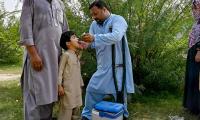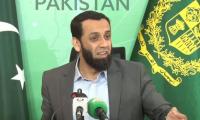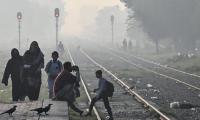The writer is an independent education researcher and consultant. She has a PhD in Education from Michigan State University.
As we entered August, Covid-19 test positivity rates (the percentage of Covid tests that are conducted and come back positive) fell below five percent.
This is welcome news, but whether this should be credited to the selective lockdowns and curfews the government dubbed ‘smart-lockdown’ or to reduced testing or whether this is because the disease has worked its way through most of the population and we have achieved some kind of herd immunity, time and further study by experts will tell.
A few weeks ago, work afforded me the opportunity to travel to the newly merged districts of Khyber Pakhtunkhwa, formerly known as Fata. Since schools there are also still closed, I saw groups of children roaming around neighborhoods, doing what children (should) do in the summertime. In Bajaur’s markets I saw children, both boys and girls, sitting in shops crowded by customers, presumably helping out or being supervised by their parents at work. As I went past a mosque, I saw a handful of children milling around the entry gate, presumably there to attend lessons.
I recall seeing only one man with a facemask, that too strapped under his chin. Nowhere did I witness adherence to or enforcement of any social distancing recommendations, least of all among children. I traveled farther to communities that are educationally underserved and that are candidates for having new public schools built. There, the closest neighbours of a mud home are hundreds of meters away, making isolation and social distancing less of a challenge. It made me wonder: if children are out and about in throngs and near adults, would these same children not have been better off in schools at this time?
Now, that the entire country has effectively reopened, schools are left as the only notable exception. Numerous studies have shown that regular summer vacations produce a measurable loss of learning equivalent to anywhere from two to three months of schooling, depending on the subject and socio-economic conditions. As school reopening is tentatively being considered for September 15, remember that this means children will be returning to schools after a massive six months long break.
A working paper, titled ‘Human Capital Accumulation and Disasters: Evidence from the Pakistan Earthquake of 2005’, by Andrabi, Daniels, and Das from May 2020 traced the effects of the 2005 earthquake in Pakistan on learning outcomes of students from households that lay on the faultline. After a school closure of only 14 weeks, when compared with a control group, after four years these children still showed a learning loss of two years of no schooling. This may translate to a loss of 15 percent of their lifetime earnings.
The most important factor in this learning loss was not the 14 weeks of missed school but can be credited to what happened to these children after schools reopened – little remedial education to mitigate losses before moving on to new contents. In addition to learning losses, we know from various studies now that the impact on psycho-social health is an equally important, if not more important, aspect to address.
I am not advocating for reckless school reopening. But the facts are that we seem to have come out of the other side of this pandemic in reasonably good shape, and for that the government can take some credit. With all sectors of the economy reopened, it is time (perhaps even past that time) to figure out a smart way to do the same for schools.
The strategy to reopen schools must be just as adaptive and nimble as the strategy to lockdown was – you can call it ‘smart-reopening’. No matter what the official guidelines may suggest, the reality is that we will not be able to throw infinite resources at the school reopening challenge like well-resourced private schools and developed economies – by conducting testing, providing personal protective equipment and ensuring hygiene and sanitation. We will also not be able to mitigate learning losses because: (a) our children were already performing below grade level; and (b) there is little evidence that provincial governments have effectively prepared for recovery.
Provincial education departments have a bureaucratic hierarchy that spans all the way from the provincial capitals down to districts and cover 317,000 public and private schools and colleges serving more than 50 million students. District education officers, with help from tehsil-level education officers, are aware of the situation on the ground in schools and communities, at the lowest level of administration. Many schools do not have enough classrooms to accommodate their enrolled students even pre-Covid, so classes are routinely conducted outside. These schools may be better able to figure out ways to follow physical distancing rules by moving more classes outside.
DEOs’ local knowledge and insight into individual schools, combined with district level health department data/ advice, can be instrumental to implementing a fine-grained smart-reopening strategy. Such an approach would also be supported by provincial autonomy on matters of education granted by the 18th Amendment.
The decision to reopen schools should not be a binary one that throws the switch at the federal or provincial level. It needs to be more fine-grained, the way lockdowns were, which were sometimes narrowly focused on problematic streets or neighborhoods. From the few major cities, to towns, to rural areas, to the most remote areas, adherence to precautionary guidelines varies between extremes. People in different areas have lived through vastly different realities through the pandemic.
Credit where credit is due, the KP School Education Department was the only department to argue in favor of a data-driven localized approach to school reopenings (twice!) at the inter-ministerial conference on education where school reopening was debated, most recently on August 5, 2020. KP suggested phased reopening with SoPs in place, following the approach many developed countries have adopted. The proposal was resisted by all other federal and provincial counterparts.
Coordination of the pandemic response has exposed constant tension between the federal and provincial governments, especially Sindh. Sindh rightly argued that decisions to open and close sectors of its economy fall under provincial purview and the center was interfering and creating confusion and undercutting its efforts by issuing contradicting statements. Just like other matters on education, the decision on when to reopen schools is also a provincial matter.
Furthermore, there is no need to pick one reopening date for the entire province. Factors influencing this decision – Covid-19 positivity rates, community adherence to guidelines, and the capacity of individual schools to adhere to guidelines for reopening – vary from one neighborhood to the next. Reopening decisions for tehsils and villages should be made at the district level with input from district health offices. Insisting on one reopening date for the entire province is shirking responsibility for a finer-grained approach, which will indeed be tedious but takes into account the fact that the children who are incurring the greatest learning losses could have possibly and safely gone to school weeks ago.
District level score cards are the new favorite policy tool of accountability of education service providers at the local level. When learning outcomes or dropouts are measured, districts/ provinces will be held responsible. The federal government will not take responsibility. So, decisions related to the process should also rest at the local level.
People who spent this time in protective bubbles could sustain this routine for another year, because they were fortunate to have jobs that allowed them to work from home while their children continued their education in online classes. For them, it will mean passing on some of life’s indulgences and contending with the difficulties of online schooling.
For a vast majority, reality looks very different. There is increasing pressure to reopen from parents of children whose schools could not conduct online classes and may be realizing that their children are falling behind. With a month to go until September 15, it is still not too late to swap out the one-size fits all approach to school reopening with a smart-reopening.
Email: arazzaque@gmail.com
It is disturbing to note that anti-tobacco NGOs in Pakistan remain silent on tax evasion in tobacco sector
Focus on growth alone, while ignoring root causes of persistently high structural poverty, undermines growth itself
Pakistan faces dual task of providing humanitarian support to refugees while ensuring safety of its citizens
ICJ has called 26th Amendment “a blow to judicial independence, the rule of law, and human rights protection”
Financial mismanagement, especially during tenure of PTI government, pushed country into abyss of heavy debt
Women are half of world’s population, but underrepresented in politics, decision-making, and leadership roles







